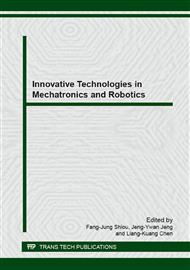[1]
L. Finch, H. Barbeau, and B. Arsenault, Influence of body weight support on normal human gait: development to fagaitre training strategy, Physical Therapy. 71 (1991) 842–855.
DOI: 10.1093/ptj/71.11.842
Google Scholar
[2]
A. L. Behrman and S. J. Harkema, Locomotor training after human spinal cord injury: a series of case studies, Physical Therapy. 80 (2000) 688-700.
DOI: 10.1093/ptj/80.7.688
Google Scholar
[3]
K. P. Westlake and C. Patten, Pilot study of Lokomat versus manual-assisted treadmill training for locomotor recovery post-stroke, J. NeuroEngineering and Rehabilitation. 6 (2009) 6-18.
DOI: 10.1186/1743-0003-6-18
Google Scholar
[4]
G. Colombo, M. Joerg, R. Schreier and V. Dietz, Treadmill training of paraplegic patients using a robotic orthosis, Rehabilitation Research and Development. 37 (2000) 693-700.
Google Scholar
[5]
S. Fisher, L. Lucas and T. A. Thrasher, Robot-Assisted Gait Training for Patients with Hemiparesis Due to Stroke, Topics in Stroke Rehabilitation. 18 (2011) 269-276.
DOI: 10.1310/tsr1803-269
Google Scholar
[6]
E. H. van Asseldonk, J. F. Veneman, R. Ekkelenkamp, J. H. Buurke, F. C. van der Helm and H. van der Kooij, The Effects on Kinematics and Muscle Activity of Walking in a Robotic Gait Trainer During Zero-Force Control, IEEE Trans Neural Syst Rehabil Eng. 16 (2008).
DOI: 10.1109/tnsre.2008.925074
Google Scholar
[7]
S. Banala, A. Kulpe and S. K. Agrawal, A Powered Leg Orthosis for Gait Rehabilitation of Motor-Impaired Patients. Proceedings, IEEE International Conference on Robotics and Automation. (2007) 4140-4145.
DOI: 10.1109/robot.2007.364115
Google Scholar
[8]
H. Stefan, W. Andreas and T. Christopher, Innovative gait robot for the repetitive practice of floor walking and stair climbing up and down in stroke patients, NeuroEngineering and Rehabilitation. 7 (2010).
DOI: 10.1186/1743-0003-7-30
Google Scholar
[9]
C. Werner, S. Von Frankenberg, T. Treig, M. Konrad and S. Hesse, Treadmill training with partial body weight support and an electromechanical gait trainer for restoration of gait in subacute stroke patients, a randomized crossover study. 33 (2002).
DOI: 10.1161/01.str.0000035734.61539.f6
Google Scholar
[10]
H. Yano, K. Kasai, H. Saito and H. Iwata, Sharing Sense of Walking With Locomotion Interfaces, INTERNATIONAL JOURNAL OF HUMAN–COMPUTER INTERACTION. 17 (2009) 447-462.
DOI: 10.1207/s15327590ijhc1704_1
Google Scholar
[11]
http: /www. iosh. gov. tw/wSite/ct?xItem=7305&ctNode=665&mp=11.
Google Scholar
[12]
W. Kim, J. Tan, A. Veloso, V. Vleck, A.S. Voloshin, The natural frequency of the foot–surface cushion during the stance phase of running. Journal of Biomechanics, 44 (2011) 774-779.
DOI: 10.1016/j.jbiomech.2010.10.041
Google Scholar
[13]
Ratcliffe, R.J.; Holt, K. G, Low frequency shock absorption in human walking, Gait and Posture. 5 (1997) 93-100.
DOI: 10.1016/s0966-6362(96)01077-6
Google Scholar
[14]
Delp SL, Loan JP, Hoy MG, Zajac FE, An interactive graphics-based model of the lower extremity to study orthopaedic surgical procedures. IEEE Trans. Biomed. Eng. 37 (1990) 757-767.
DOI: 10.1109/10.102791
Google Scholar
[15]
J. Hidler, D. Nichols, M. Pelliccio, K. Brady, Advances in the understanding and treatment of stroke impairment using robotic devices, Top Stroke Rehabil. 12 (2005) 21-33.
DOI: 10.1310/ryt5-62n4-ctvx-8jte
Google Scholar
[16]
Hidler JM, Wall AE: Alterations in muscle activation patterns during robotic-assisted walking. Clin Biomech. 20 (2005) 184-193.
DOI: 10.1016/j.clinbiomech.2004.09.016
Google Scholar
[17]
Hesse S and Werner C. Connecting research to the needs of patients and clinicians. Brain Research Bulletin. 78 (2009) 26–34.
DOI: 10.1016/j.brainresbull.2008.06.004
Google Scholar


